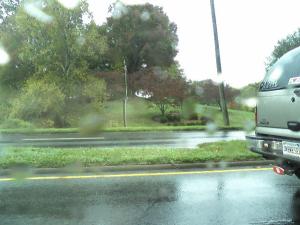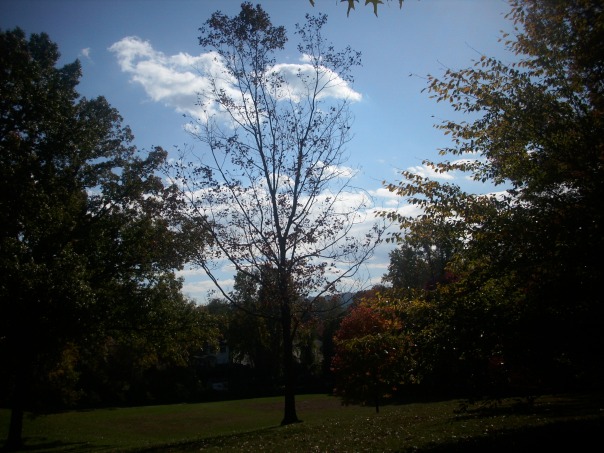There’s this one shopping center I pass every day on the way to work. Its landscaping ignites repulsion in me – a wince and a cringe that feels physical, like a splinter you can’t ignore.

My disgust roots in on the:
a) ugly aesthetic that shaped the evenly planted pines
b) nondescript shrubbery and shabby grass, lacking any care or attention
c) obvious treatment of the fauna as accessories, belying a lack of care or love or relationship to the other life on this planet
d) cheap, boring construction
e) fact that I have to live in a contemporary society that builds these ugly areas of commerce
My aversion feels so strong, I feel a hatred for this industrial society, for this western culture, for myself, even, for my participation in it. I want to run away somewhere idyllic and beautiful, I don’t want to live here, I want to belong to something lovely, where I don’t resent my environment, where the People in Charge care about beauty and everyday experience instead of the bottom line.
Kind of an awful feeling.
Today, however, something different happened.
I was on the same road, in the same traffic, viewing the same row of straggly trees edging the same lousy grey store fronts. Instead of the usual twinge – there was the memory of my son’s amputated plastic frog.
The Ugly Frog
Every so often, I sift through the constantly mounting collection of toys and sticks and paper scraps in my kids’ rooms and move them to the basement – a kind of staging area before they leave the house for good.
Sometimes when I do laundry, if I’m not careful, my son Sam follows me downstairs and ‘discovers’ old favorites that he’d completely forgotten about and the enchantment with the toy or stick or scrap revives.
Yesterday, he found a once-treasured rubber frog.
It is a very, very ugly frog. It is rubbery in a slimy way, neon orange and yellow, dirty, and full of holes. But Sam hugged it to his chest in delight.
Upstairs, however, his face crinkled up.
“His leg is gone,” he cried, holding up the nasty little thing and showing where a back leg was indeed missing. “I don’t want him anymore.”
“You can’t love him with a missing leg?”
“Noooooo….,” he wailed. And threw the thing to the ground in a huff.
I should have been relieved.
Instead, I was kind of disturbed for the poor, ugly little frog.
And that little, mishapen, unwanted, and hole-y hunk rose in my mind like a flag when I saw the boring ugliness today.
My heart, awakened to compassion for the rejected frog, was still open, its doors hinged with compassion.
Loving the Unloveable
Maybe the landscapers and developers who plopped these trees down, poured concrete slabs around them, plugged in those bushes, maybe they didn’t love these life forms, but – how could I not? Love them despite their conditions, despite their ugly situations, despite their predicament?
Even as they are, broken, ordinary, each tree has its own movement in the little bit of wind, its own graceful leaning, each stretch of grass and bunch of bush sparkling a little in the sun. No, the scene wasn’t beautiful as such; I could not scrawl edits over them, pretty them up with lies about their poses. But I could love them as-is. Take them for what they are.
This was not a feeling I forced into myself, tried to feel, or a state of mind I attempted to install. Rather, I believe it flowed naturally from my practice in compassion and mindfulness, my practice of accepting and loving What Is.
It’s not an easy practice.
We want our toys, our people, our lives, our shrubbery, our surroundings, our relationships to be whole, lovely, easy, complete. A toy with a broken leg, a person with a sour disposition, a coworker who cusses, institutional plants, divorces, unrealized dreams – these don’t only leave us dissatisfied and disappointed. They often make us feel like things are Wrong, to be escaped or avoided.
When we love someone or something, we open our hearts to it, we connect with it, we claim it, in a way, mark it as loved. You can’t really love someone and at the same time offer a disclaimer to the world that you have no association with the beloved.
You know – that’s why people have their Likes on Facebook pages, and bumper stickers on their cars that say “I love hiking.” What we love defines who we are.
If you say, “I love the gorgeous Blue Ridge Mountains,” or “I love the south of France,” others will nod in appreciation, concluding you have great taste.
If you say, “boy, that’s a nice stretch of trees at the strip mall,” others will think you are deficient in numerous ways – as deficient as the strip mall itself.
To love something that’s broken is to allow for brokenness. You are connecting to it, claiming it, holding it, cradling it. And you are implicating yourself – guilt by association. Someone might see you loving the ugly thing and think you are therefore ugly. Someone might judge you to be unworthy of love.
Loving truly requires bravery, and honesty. For if we are honest, none of us is without broken parts, disfigured features, unpleasant qualities. We’ve all been besmirched by some run-of-the-mill imprinting by our commercially focused society.
Love is…
But love, as the Bible says, heals all wounds. For in love, the idea of wrong or right really don’t matter. Love is not a moral judgment. Love is not an aesthetic appraisal. Love is not about the worthiness of the beloved. Love is about the worth of all that is. It is the big open space that accepts all things within it.
Learning to love those trees, to accept them, not only unbinds my heart, but reveals something to me truer than my judgments of ugly or beautiful. There’s an intimacy, a feeling of belonging that blossoms, or begins to. Part of my aversion to the ugly things meant separating. Instead of turning away, but accepting them for what they are, I am accepting reality. I’m here. I live here. I live around these trees that are like this. It doesn’t mean I’m blind to the situation. It means I really see it, I really see them, in the clear light of compassion, which I am suddenly seeing and believing is more truthful and accurate than the cold harsh logic of teethy judgment that I was brought up to believe was Right.
This is a huge mental reversal for me.
A Guide to Action
And of course, when it comes to considering proper or right action, which is the best guide? Judgment, hatred, disgust? Or love?
- Acting out of disgust for this landscaping, I might just run away, call for its eradication, want it leveled, have them all killed. Or just ignore their plight.
- But acting out of love, endearment, I will want to feed and save the trees, I will want to plant more plants around them, I will want to make this mall this town this world a more pretty and beautiful place, out of love, out of a sense that this is my home, that I care for it, that I want to treat it tenderly.
I honestly have never wanted to care about ugly malls, or boring tasks, or dumb subdivisions, or annoying eco-unfriendly highway construction – I’ve just wanted to hate it and hope it doesn’t get too close to me. I haven’t wanted to pay attention to it, because I hated it all so much.
This aversion feels like a dull pounding of a hammer in my head. When my heart opens, that pounding ceases. Things aren’t ugly and boring and abhorrent. Even the people in charge of their creation aren’t. The frog’s leg doesn’t reappear. It’s still a frog with a broken leg. But through love my perspective changes, and they are loved, not because they deserve it, but because it is the way I am learning to perceive everything – as connected, as one, as part of each other – and loved for their very virtue of Being. Loved for existing. In whatever battered shape they happen to exist. In the way a mother loves her new baby – the baby has done nothing to earn that love but be born.
Could it be – our very nature – the very nature of being – is love?
All Worthy
Of course, as I write this, I can’t help but have hovering in the background the many instances of conditional love – of love taken away – of judgment dressed up in a false costume of love – that I and my fiancee and many people around the world have experienced. These instances teach us the entirely wrong thing. We grow up believing we aren’t worthy of love.
But there is no such thing. We are all worthy.
And so I am thankful for that ugly stretch of stores on my daily commute I have always hated passing, for that frog I had shoved in the basement, hoping it would be gone from my sight forever. Look how important they have become for me, what great teachers they have turned out to be! Proving again, how precious even the smallest, crudest thing can be when we give it our attention, when we see it for what it is, as something that exists, and therefore deserves, as we all deserve, love, kindness, compassion, happiness. Each and every one of us.

